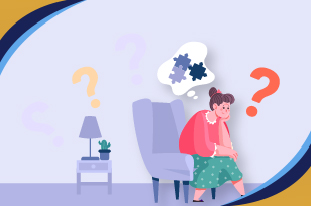Everyone has experienced anxiety or panic at one point in their lives. But when sudden bouts of panic attacks start to happen it means you are probably suffering from panic disorder, which can be a debilitating mental condition and can interfere with your or your loved one’s everyday life. People tend to know that a panic disorder is a mental condition but most of the time they wonder about if it is a disability too, and they phrase their questions like this, “Is panic disorder a disability?”. We are here to answer that question after we have provided you with some brief background on panic disorder.
What is Panic Disorder?
What we are going to discuss in this section is more of a basic overview of the condition rather than something that directly addresses the question, “Is panic disorder a disability?”A panic disorder is defined by recurrent and spontaneous panic attacks that can ravage someone’s life. Panic attacks are responses to stimuli that may present themselves as something dangerous to the sufferer, even when the danger is actually not there..
During a panic attack, you feel a rush of intense feelings of anxiety that can come and go for no apparent reason. Certain psychological or physiological symptoms make this type of mental condition more evident.
These symptoms can range from:
- Wooziness
- Bread
- Sweetness
- Tingling in your hand or your fingers
- Feelings of impending danger
- Shaky limbs
- Fear of losing the control of your mind
- Feelings of uncertainty and detachment
- Lightheadedness
- Chills or hot flashes
- Fear of untimely death
- Racing heart rate
The physical and psychological symptoms can be overwhelming, which can cause a lot of distress in the affected individuals and the torment they go through does not go away. Afflicted individuals live in the fear that this thing might be handicapping and hindering them from living life to its fullest potential and constantly wonder if this mental affliction is a disability. They also frequently wonder and ask themselves or the people around them questions like “Is panic disorder curable?”.
The Prevalence of Panic Disorder in The United States of America
While panic disorder affects millions of people globally, around 4.7% of the adult population in the USA has suffered from the mental condition of panic disorder as reported by the National Institute of Mental Health (NIMH). This roughly translates to 12.1 million people suffering from spontaneous and recurrent panic attacks in the USA alone. Women tend to have more panic attacks than men and first symptoms mostly strike in early adolescence and young adulthood but can also present itself in early childhood or much later in life.
So, Are Panic Attacks a Disability?
A lot of questions that are asked related to panic disorders predominantly relate to it being a disability. The answers to these questions like, “Is Panic Disorder a Disability” are never straightforward, as under some circumstances it is indeed considered to be a disability and in some situations, it might not be considered a disability. So, the context of where it is used as a disability can be different, so, let’s see how:

American Disabilities Act (ADA)
Signed into the legislative law of the United States of America in the 1990s, the ADA offers protections against discrimination against people with disabilities. This law guarantees that any person with disabilities is entitled to the same opportunities, purchasing power, and participation in government programs, as a normal person would be. In addition to this, this law considers anything that “substantially limits one or more major life activities” as a disability.
So, keeping this in mind, and according to ADA, something that interferes with everyday life is considered to be a disability. In that way, panic disorder is known for severely affecting the daily lives of affected individuals and therefore, can be classified as a disability, therefore answering a question like, “Is panic disorder a disability?”. But it is only done so when a mental health professional indeed diagnoses it as something that is affecting the life of the patient this much. Then only it is considered to be a disability. In order to be classified as a panic disorder-stricken disabled person, and to qualify for the work-related protections as prescribed by the ADA, the affected person needs to show evidence that they can work while working with this mental health condition through recommended accommodations.
Social Security Administration (SDA)
Much like ADA, to qualify for the SDA benefits, a simple diagnosis of panic disorder is not sufficient. One has to provide proof that the panic attacks they have been suffering from are so severe and occur so often that they have not been able to work for more than a year or so.
Handicap Parking
When it comes to disabled or handicapped parking, the answer to the question, “Is Panic Disorder a Disability” is not the one you are looking for. Getting a disabled/handicapped permit for a designated parking, panic disorder or even any other mental condition for that matter is not possible. We are confident that most of the states in the whole of the US, do not differ much in this same context.
State-Level Protections
What benefits are prescribed through state-level government programs is solely dependent on the particular state you or your loved ones, who might be asking the question, “Is Panic Disorder a Disability”, are residing in. You can check the websites of these state-level programs to get better information regarding panic disorder and its status as a disability.
Is Panic Disorder Curable?
While this might be a little off-topic to the question, “Is Panic Disorder a Disability”, it is our civic duty to lay down some of the ways it can be treated. Similar to other mental conditions like chronic anxiety and clinical depression, panic disorder is not curable but is essentially treatable through a range of different methods. These methods are:
Psychotherapies:
Psychotherapies like Cognitive Behavioral Therapy (CBT) are the most suitable for treating something like panic disorder which some might consider a disability. In CBT, experts will help you come to terms with the negative thought processes that might contribute to problematic behavior, which in this case tends to be related to panic disorder.
There is a certain type of CBT called exposure therapy where a mental health professional will try to get affected individuals to walk through the same scenarios in which they might feel that panic attacks could be triggered, so they do not have the same power over the same individual again.
Medication:
There are certain medications that can be used for treating panic disorder and its symptoms. How treatment in terms of medication will go, is totally dependent on the type of medication itself. A psychiatrist can review how a treatment goes through a particular medication and adjust the dosage and the type of medication accordingly. Some of these medication types are:
Selective Serotonin Reuptake Inhibitors (SSRIs) and Selective Serotonin-Norepinephrine Inhibitors (SNRIs):
These are the commonly prescribed antidepressants, most often used for treating depression but can also be used for treating panic attacks. This type of medication blocks the reabsorption of the neurotransmitter called serotonin back to the neurons, so more serotonin is active in the brain as this is the brain chemical that is used for regulating mood and feelings and therefore can help treat problems like anxiety and irrational fear. Similarly, Selective Serotonin-Norepinephrine Reuptake Inhibitors (SNRIs) also target serotonin along with norepinephrine, a hormone and chemical messenger that works like serotonin in the body. Medications like these can take up to 2 to 4 weeks to treat panic disorder and can have certain side effects like headaches associated with it.
Beta-Blockers:
Medications like these are used for treating the physiological symptoms of panic disorders that include but are not limited to problems such as rapid heart rate, sweating, and tremors. While this type of medication may not treat panic disorder itself, it can help treat the symptoms that are evident during the onset of the panic disorder.
Anti-anxiety Sedative Medication:
Anti-anxiety Sedative medications such as Benzodiazepines are also used to effectively treat mental conditions like panic disorder but people can build a tolerance once they are on them and therefore can lead to dependency. This is why mental health professionals avoid prescribing this type of medication to people suffering from panic disorder unless it becomes necessary.
Final Words on Treatment
Both of the treatment methods can either be used separately or as a combination of both of these methods to help with resolving issues that are related to panic disorder. Again, their progress will be highly dependent on what type of treatment suits best to patients, whether combined or not. While not directly related to the question, “Is panic disorder a disability,” treatment expounds on how you can prevent symptoms from becoming consistent enough to become a disability.
Concluding Words
So does this answer the question, “Is panic disorder a disability?” We would like to say that we have done a considerate job. We also tried to expound on the question “Is panic disorder curable.” With all said and done we did provide some answers and focus on the theme that under one context the answer to the question of, “Is panic disorder a disability” is an empathetic yes! To help with this, we at Orange Coast Psychiatry, provide more than answers to the question “Is panic disorder a disability,” as we provide services for mental health conditions like panic disorder and we do so in a consistent, continuous, and sophisticated way.


















